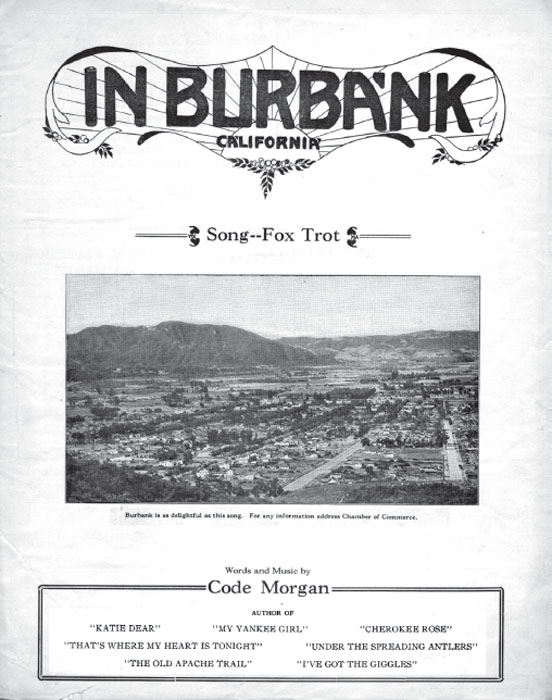
The sheet music to Code Morgan’s magnum opus. Collection of Michael B. McDaniel .
5
MUSICAL BURBANK
Where you have people, you have music. Where you have a media capital, you have unusual and even extraordinary music. This chapter examines musical Burbank; there are some interesting tales and lost lore therein.
BURBANK ’S OFFICIAL SONG I
The authors know of no official Burbank theme song, that is, one that is presented as such at civic occasions or has been designated as such by the city council or mayor. But there are a couple of contenders for the title. The first, “In Burbank,” was written in 1924 by Code Morgan, author of “The Old Apache Trail,” “Under the Spreading Antlers” and, best of all, “I’ve Got the Giggles.” The sheet music shows a hillside view of Burbank with the caption, “Burbank is as delightful as this song. For any information address Chamber of Commerce.” Morgan was reportedly a Burbank High School graduate. Both the music and the words are by Morgan, and the song is described as being in a foxtrot rhythm.
There used to be a clever arrangement of it on YouTube, but that has unaccountably disappeared. Nevertheless, one of the features of our occasional Burbankia slide shows held in Burbank libraries is a singalong of this tune. After you’ve heard it about 427 times, it begins to grow on you.

The sheet music to Code Morgan’s magnum opus. Collection of Michael B. McDaniel .
IN
BURBANK
By Code Morgan
Way out west, I’ve built a nest ,
In a spot that Nature surely blessed ,
’Tis the place I love the best ,
Everywhere sunbeams rest ,
In the Valley ’neath the mountain crest .
I’ll never stray far away ,
For there’s peace and rest both night and day ,
Soft breezes sway ,
Flowers by the way ,
And even all the songbirds seem to say:
Chorus
In Burbank, In Burbank ,
Way out in Burbank, California ,
I want to warn you ,
Don’t let your footsteps stray ,
When you start to come this way ,
For you will surely stay ,
Until the Judgment Day .
In Burbank, In Burbank ,
There’s no place on earth that could be fairer ,
That’s no error .
There’s a happy throng ,
Just ten thousands strong ,
And in Burbank Town you can’t go wrong .
BURBANK ’S OFFICIAL SONG II
The invaluable 1944 Burbank Community Book by George Lynn Monroe contains the following candidate as an official Burbank anthem:
It fell to the lot of W.P. Coffman, at one time Postmaster, former owner and publisher of the Review, and still holding down an important position on that paper, to write what might be called the community’s official song. It was originally intended for the Kiwanis Club, is sung to the tune of “Tramp! Tramp! Tramp! (The Prisoner’s Hope)” composed in 1863 by George F. Root .
BURBANK
’S
OFFICIAL
SONG
By W.P. Coffman
There’s a town in Southern Cal
That we love just like a pal ,
Where we work, and boost, and sing, and dance, and play .
There’s no other place in sight
That can give us more delight ,
And we’re full of pep and ginger
When we say:
Chorus
Bank, Bank, Bank, we bank on Burbank—
Bank on Burbank every day .
Nestled up against the hills
All our hearts with pride she fills—
Yes, we bank on Burbank and we’re here to stay .
When this whole Kiwanis bunch
Gets the right and proper hunch
Everybody gets behind us with a swing .
All for one, and one for all .
[Possibly missing line]
That’s what makes us want to get
Right up and sing .
Chorus
Bank, Bank, Bank, we bank on Burbank—
Bank on Burbank every day .
Nestled up against the hills
All our hearts with pride she fills—
Yes, we bank on Burbank and we’re here to stay .
BE TRUE TO YOUR SCHOOL
The Burbank High School 2008 centennial commemorative book The Blue and White Wave High gives an interesting story of an instance when an enthusiastic BHS co-ed inspired the legendary Beach Boys songwriter Brian Wilson to pen the hit song “Be True to Your School”:
As a child growing up in Burbank, Jodi Gable (Class of 1965) fondly remembers the grape arbors that filled the hillside above her house and describes her life as living in “a Norman Rockwell painting.” When Jodi was 13 she met the Beach Boys at an Olive Rec Center dance and was amazed at their sound. After talking with them she was asked to head up their fan club. After her parents met the Wilsons (parents of Brian, Dennis and Carl), Jodi began hanging out with the boys, who treated her like a sister, and building fan support .
“I loved BHS and couldn’t wait to get to school each day,” she recalls. “I called Dr. Leland, ‘Unc,’ and I had teachers who really seemed to care.” Jodi was an active member of the Drill Team, and her loyalty to BHS became the genesis of one of their hits. Jodi recalls, “Brian Wilson was a genius and could come up with lyrics on the spot. We were eating chili fries one day at an A&W in Hawthorne and he penned, ‘Fun, Fun, Fun.’” Jodi was driving the guys crazy with her drill team stories and Wilson came up with “Be True to Your School” (which coincidently contains part of “On Wisconsin,” Burbank’s fight song). On her 16th birthday, the Beach Boys threw a party and performed in her back yard .

Jodi Gable, the girl who drove Brian Wilson crazy with her Burbank High School spirit, on her first date with Beach Boy Dennis Wilson, circa 1962. Jodi Gable Firgens .
The book ends with the reassuring information that Jodi “has stayed connected to her classmates and has always remained true to her school.” As do all good Burbank High School Bulldogs!
BURBANK POLICE BOYS BAND
Burbank has the reputation of being a socially conservative community; whether this is still true or not is open to speculation. At one time the community had a musical ensemble for boys that was associated with the Burbank Police Department, called the Burbank Police Boys Band. It was sponsored by the city’s Parks and Recreation Department. Members, numbering from forty to one hundred, dressed in uniforms reminiscent of police officers. In fact, they looked like small-scale policemen. The black uniforms were reportedly hot and uncomfortable in the summer months.
The band began in 1953, founded by Ben Porter. The very first members gathered in a building at McCambridge Park for Monday evening rehearsals. Marching practice took place in a local parking lot. Not surprisingly, the band drew its membership largely from Burbank junior and senior high schools. Parents did what parents always do: formed a group of supporters and kept track of sheet music, scheduled concerts and parades, maintained the uniforms and performed the other usual functions of a booster organization.
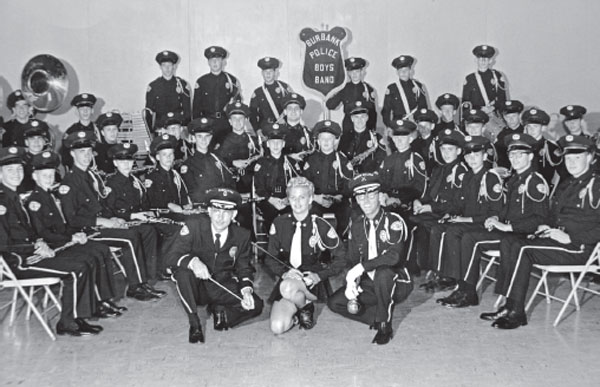
An undated image of the Burbank Police Boys Band. During the anti-establishment 1960s, it was known as the Fuzz Band. Burbank Historical Society .
The band was initially an all-boys ensemble (girls were admitted in the 1970s). But girls served as majorettes and members of the color guard. Fierce competition soon erupted among the boys to seek the attention of the girls. In the 1960s the band humorously referred to itself as “the Fuzz Band,” an allusion to a dismissive and uncomplimentary countercultural slang term for police officer.
Bill Kuzma, a former director of the band as well as a former band member and drum major, reports that the famous film director Tim Burton was a clarinet and sax player in the Boys Police Band in the early 1970s and was elected leader of the officer group. Another well-known member of the band was Anson Williams, known as “Potsie” in Happy Days . He, too, played the clarinet.
An anniversary concert was staged every spring, when alumni were invited to play. Some of these were professionally recorded and appear on vinyl LPs. (One of these appeared in an art show of personal items owned by Tim Burton.) The band also participated in the annual Tournament of Roses Parade, sometimes by itself and sometimes with the two Burbank high school bands. The band’s main tunes were “The South Rampart Street Parade” (its signature piece), “Strike Up the Band/I Love a Parade,” “Horns A-Plenty,” “High Society” and “The Soaring Eagle.”
The Burbank Police Boys Band was discontinued in the 1970s and is now but a fond memory for its past members.
RANDY RHOADS
Sometimes what is lost from a community is a promise of what could have been. Such a loss was legendary rock guitarist Randall William “Randy” Rhoads (Burbank High School, class of 1975). He lost his life in an airplane crash in 1982 at age twenty-five. Rhoads, a founder of the influential rock group Quiet Riot along with original member Drew Forsyth (BHS class of 1974), was a different sort of rock guitarist. His mother, Delores, was a music teacher and managed a music store; Rhoads began with classical training on the guitar and, as a sixteen-year-old, taught the instrument at his mother’s store. When he played at home, he played loud. As a result, he got to know many of the Burbank policemen by name. By the time he was in his twenties he was considered one of the best guitar teachers in the Los Angeles area. While at Burbank High, Rhoads was a casual sports participant. He often ran remedial laps and wore two softball mitts to preserve the touch in his hands and fingers. His rise to fame with Ozzy Osbourne is the stuff of rock legend.
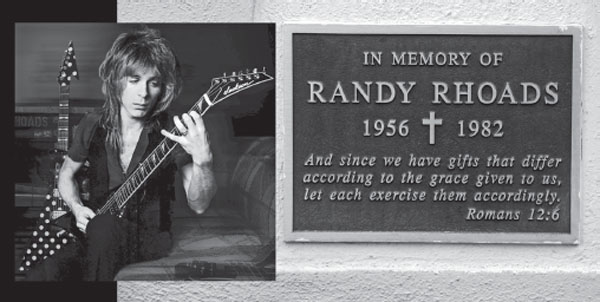
Randy Rhoads and the memorial plaque at the First Lutheran Church. www.randy-rhoads-online.com/Wes Clark .
The Rhoads family worshipped at the First Lutheran Church at 1001 South Glenoaks Boulevard. Within the church grounds is a memorial plaque to Rhoads. To honor his memory there are also music scholarships in his name at UCLA and Cal State Northridge.
THERESA /ATHENA
Burbanker Theresa Russell was born Theresa Paup in San Diego, California; she attended Burbank High School and appears in the 1973 yearbook, but she did not graduate. She married English film director Nicolas Roeg in 1982.
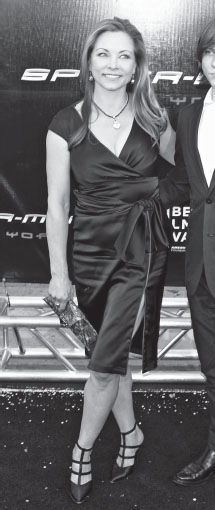
Burbanker Theresa Russell (Theresa Paup), jilter of rock stars, in 2007. David Shankbone/wikipedia Creative Commons .
Pete Townshend of The Who says that Russell was the inspiration for his song “Athena,” which was first called “Theresa.” From the Wikipedia entry for the song:
Pete Townshend wrote this song after an encounter with actress Theresa Russell. He promptly fell in love with her, and his frustration of being rejected is contained in this song. In this context, associated with an issue with a film director, it became a subplot of the much later The Lifehouse Chronicles. Townshend initially changed the title to “Athena” to disguise who the song was really about .
Some Burbank girls are girls—others, as Townshend’s song insists, are bombs.
THE LAST LENNON AND MC CARTNEY GIG
It’s a fun question the authors ask at Burbankia slide shows: “Where was the last John Lennon–Paul McCartney gig held?” Since a roomful of people are assembled to hear fun facts about Burbank, the answer is obvious: Burbank. Wikipedia gives the details:
A Toot and a Snore in ’74 is a bootleg album of the only known recording session in which John Lennon and Paul McCartney played together after the break-up of the Beatles. First mentioned by Lennon in a 1975 interview, more details were brought to light in May Pang’s 1983 book , Loving John, and it gained wider prominence when McCartney made reference to the session in a 1997 interview. Discussing it with Australian writer Sean Sennett in his Soho office, McCartney claimed the “session was hazy…for a number of reasons.”
Lennon was producing Harry Nilsson’s latest album , Pussy Cats, when Paul and Linda McCartney dropped in after the first night of the sessions, aka “the Jim Keltner Fan Club Hour” at the Burbank Studios on 28 March 1974. They were joined by Stevie Wonder, Harry Nilsson, Jesse Ed Davis, May Pang, Bobby Keys and producer Ed Freeman for an impromptu jam session .
Lennon was in his “lost weekend,” separated from Yoko Ono and living in Los Angeles with Pang. Although he and McCartney hadn’t seen each other in three years and had lashed out at each other in the press, according to Pang they resumed their friendship as if nothing had happened. The jam session proved not very productive musically. Lennon sounds to be on cocaine and is heard offering Wonder a snort on the first track, and on the fifth, asks someone to give him a snort. This is also the origin of the album name, where John Lennon clearly asks: “You wanna snort, Steve? A toot? It’s goin’ round.” In addition, Lennon seems to be having trouble with his microphone and headphones.…The events of this night are intriguing to Beatle fans as it is the only known instance of the former songwriting team playing together between their 1970 formal breakup and Lennon’s murder in 1980. Aside from informal, special occasions such as weddings, collaborations of more than two ex-Beatles were rare after the band’s bitter 1969–70 split, especially between Lennon and McCartney, whose conflict was the most pronounced and long-lasting .
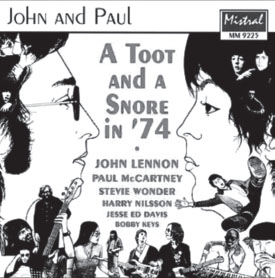
A Toot and a Snore in ’74 , a recording of the last time Paul McCartney and John Lennon jammed with each other. Wikipedia .
101 STRINGS
There were many contenders for the title of most ubiquitous Beautiful Music performers of the 1960s and the 1970s—the Anita Kerr singers and the San Sebastian Strings come to mind. But based on appearances in record bins in grocery stores across America, the king must have been the 101 Strings espousing “The Sound of Magnificence.” Their records were everywhere, and included such titles as The Emotion of 101 Strings at Gypsy Campfires, A Mediterranean Cruise to The Rivieras—Spain, France, and Italy and Concertos for Lovers . The ensemble also recorded the popular The Soul of series (Spain, Mexico and Poland were a few of the nations having their souls explored). The 101 Strings’ violins, violas, cellos and basses could be heard dramatically cascading through the scales on turntables, FM dials and in elevators across the country.
While the 101 Strings was, in reality, the Orchester des Nordwestdeutschen Rundfunks Hamburg (the Northwest German Radio Orchestra of Hamburg), with recordings made in Europe, the pressing plant for all of that vinyl was in Burbank, at the Alshire facility at 1015 Isabel Street. Alshire Records is now defunct. To confirm the location, the authors once stopped by the business currently at that address and asked around. While nobody there had ever heard of the 101 Strings (you’d have to seek out somebody at least fifty or sixty years old for that), the twenty-something at the front counter did confirm that, yes, an organization named Alshire had once pressed vinyl at the location.
DEL CASHER , FATHER OF THE WAH PEDAL
The name of guitar session man Del Casher is perhaps not as well known as that of Les Paul or Leo Fender, but this fleet-fingered musician has performed and recorded with the likes of Elvis Presley, Les Paul, Eddy Arnold, Connie Francis, Bobby Vinton, Julie London, Bobby Troup, Buddy Rogers, Bob Hope, Peggy Lee, Buddy Ebsen, Donald O’Connor, Danny Thomas, Sammy Fain, Bob Russell, Paul Francis Webster, Burt Bacharach, the Ray Conniff Orchestra, Sonny and Cher and Frank Zappa. Casher has appeared as a guest soloist on the Lawrence Welk Show 27 and is regarded as the father of the guitar wah pedal, later used so flamboyantly by Jimi Hendrix and Isaac Hayes. The latter’s “Theme from Shaft ” is practically a wah pedal anthem.
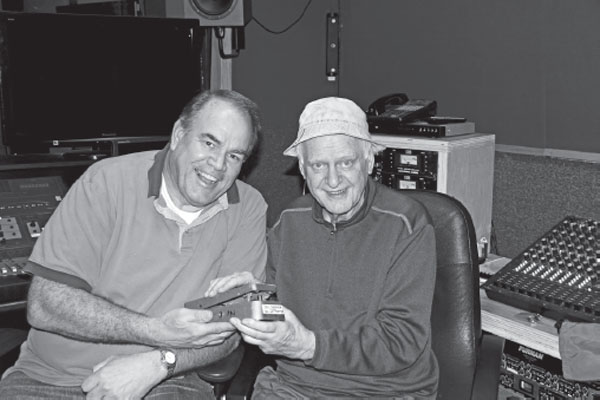
Wes Clark (left) and guitar legend Del Casher in his recording studio in Burbank. They’re holding a wah pedal prototype from the early 1960s. Michael B. McDaniel .
In the early 1970s, when the nation was traumatized by evening news reports about Vietnam and Watergate, Casher composed a soothing guitar instrumental that was in stark contrast to the forceful news show music. It was used for the closing credits of the NBC Evening News . It played for an amazing eighteen years.
The Burbank connection? Del owns the California Digital Post, Inc. recording studio on 2700 West Magnolia Boulevard. Stop by and say “Hi!” to a guitar legend!
(Note: When Del was a twenty-something musician in the early 1960s, he lodged in a converted garage in a house rented by Wes Clark’s family in Los Angeles; Del became a family friend. It was fun listening to him fiddle around with electronics and various guitar sound devices.)
It’s worth mentioning that the Tel-Ray Electronics Manufacturing Company, Inc., which built the Morley Wah pedal, was located at 2301 West Victory Boulevard, right at the corner of the street where Wes Clark lived.
BURBANK ’S TWO SYMPHONIC ENSEMBLES
The Burbank Symphony Orchestra began in 1943, when it was founded by Leo G. Damiani. The orchestra made its concert debut at the Olive Avenue Recreational Center; it was sponsored by the Parks and Recreation Department. In 1953, the orchestra, under Damiani’s leadership, performed a Christmas program on NBC, which represented the first time a West Coast orchestra had been televised by a major network. A similar program was produced the following year.

The Burbank Symphony Orchestra, conducted by Leo Damiani, in the Olive Recreational Center, 1940s. The center was the orchestra’s home before it moved to the Starlight Bowl. Collection of Michael B. McDaniel .
Leo Damiani resigned in 1959 and was replaced by Constantin Bakaleinikoff, who had a long and successful career as a Hollywood film composer before his tenure in Burbank. 28 Dr. Leo Arnaud replaced Bakaleinikoff in 1964 as conductor of the Burbank Symphony Orchestra. Arnaud, another successful film composer, is primarily known for his fanfare “The Bugler’s Dream,” used as the theme for the Olympics as broadcast by American networks.
In the 1960s Burbank supported no fewer than five musical ensembles: the Burbank Symphony, the Youth Symphony, the Choral Club, the Civic Light Opera and the Police Boys Band. The city budgeted $37,000 for the support of these groups, and more support was gathered from contributions by the public. But by the early 1980s the Burbank Symphony Orchestra was reporting money woes, and at some point in the 1990s it discontinued its active musical seasons.
Happily, not all was lost in the symphonic life of the city. The Burbank Chamber Orchestra, founded in 1991 under the direction of Steven Kerstein, who served as the conductor and music director, debuted in 1992. Ten years later it became the Burbank Philharmonic Orchestra. A donor- and grantsupported 501(c)(3) organization, the Burbank Philharmonic now brings world-class concert music free of charge to Burbank and Southern California. Since 1992 the philharmonic has performed for more than 115,000 attendees.
THE BURBANK COMMUNITY BAND
Lockheed’s wartime employees were an outgoing bunch who spent long hours at the plant; that being the case, recreation was important. One of the many pursuits for employees was the Lockheed Concert Band. 29 The first corporate mention of this ensemble was in a Lockheed Employees Recreational Club (LERC) calendar for Monday, April 22, 1940. It mentioned that band practice was held at the John Muir Junior High School cafeteria at 7:30 p.m. The band entertained employees at various locations at noon breaks. 30 By the early 1980s, the band rehearsed at the Robert E. Gross Park (owned by Lockheed) on Friday mornings. The band was led by Domenic Schieffo and managed by Anne Boscke, who worked in the Lockheed Planning Department and was also the band vocalist.
When Lockheed moved from Burbank to Palmdale, California, in February 1993, the band remained in Burbank. Eventually, Lockheed donated Gross Park to the City of Burbank, with the stipulation that the city continue to support the band by providing rehearsal space free of charge. The band continues to rehearse there. The present name of the ensemble, the Burbank Community Band, was adopted on November 14, 1997. While Lockheed is gone, the band still exists. In fact, in 2012 a board of directors was formed, and the band was incorporated as a 501(c)3 charitable organization. The band performs at various occasions, as well as at events sponsored by the Burbank Veterans Committee.

Lockheed employees listen to a lunchtime performance by the Lockheed Band, 1940s. Collection of Michael B. McDaniel .
THE BURBANK CHORALE
The original name and the women-only membership rules are lost, but the singers continue to perform. The present-day organization is known as the Burbank Chorale, but it was formerly known as the Burbank Choral Club. Founded in 1920, it has the distinction of being the oldest continuously performing arts organization in the San Fernando Valley and one of the oldest musical organizations in the state of California. It was originally made up only of feminine voices; men were barred from membership. That changed later. In 1932, the Burbank Choral Club was represented in the Olympic Chorus, which performed during the Olympic Games in Los Angeles. It also performed at the World’s Fair expositions in San Diego (1935) and San Francisco (1939).
DISNEY MUSIC
You may have never stepped into the boundaries of the city of Burbank and you may be entirely unfamiliar with the city or its inhabitants, but it’s a sure bet that you are very familiar with music created and/or recorded in Burbank by the Disney organization. Reflect that every song appearing in nearly every Disney film released after Snow White and the Seven Dwarfs in 1939 was likely arranged, performed and recorded in Burbank. Disney used the proceeds from Snow White to build the campus in Burbank.
In fact, the (infamously) most performed and translated song of all time, “It’s a Small World,” is a product of the studios on the Burbank campus. While the song has some competition for ubiquity and performance with the Beatles’ “Yesterday” and the Righteous Brothers’ “You’ve Lost that Lovin’ Feeling,” the song’s composer, Robert Sherman Jr., pointed out in a songfact.com article that “the thing to remember is that ‘It’s A Small World’ is not a radio song and the ‘Most performed or translated’ assertion does not necessarily apply to radio performances or internet downloads for that matter.…It is not limited to one venue or another (i.e. ringtones or radio plays). For example, neither ‘Yesterday’ nor ‘Lovin’ Feeling’ are featured on an amusement park ride which plays non-stop, 16 hours a day on an endless loop in four (soon to be five) locations worldwide.”
Sherman’s point is valid: it might be that there is not a moment when “It’s a Small World” is not playing somewhere on Earth. Consider that when you’re trying to get the tune out of your head; you carry the ultimate earworm courtesy of the fine folks in Burbank, California.
STARLIGHT AMPHITHEATRE
The origins of what later came to be the Burbank Starlight Amphitheatre center on Maestro Leo Damiani’s outdoor rehearsals with his musicians in a naturally shaped ravine in the foothills above Burbank. Damiani founded the Burbank Symphony Orchestra in 1943 and the Burbank Youth Symphony in 1948. Something of a musical sensation began at the site, which came to the attention of the Burbank City Council. With Damiani’s enthusiastic urging, the city began work on a formal structure with formal seating (listeners originally sat on logs). Built in 1950, the Starlight today seats three thousand people in chairs and two thousand more on the lawn. 31
The facility hit a financial rough spot in the early 1980s. The Starlight was described as “perennially troubled” and “years away from financial stability” in a September 27, 1984 Los Angeles Times article. The article also described problems with city officials affronting artists like Bette Midler and Toto by describing them as “disruptive.” On evenings with other acts, the Burbank police criticized the facility for drug and alcohol abuse, parking shortages and inadequate security.
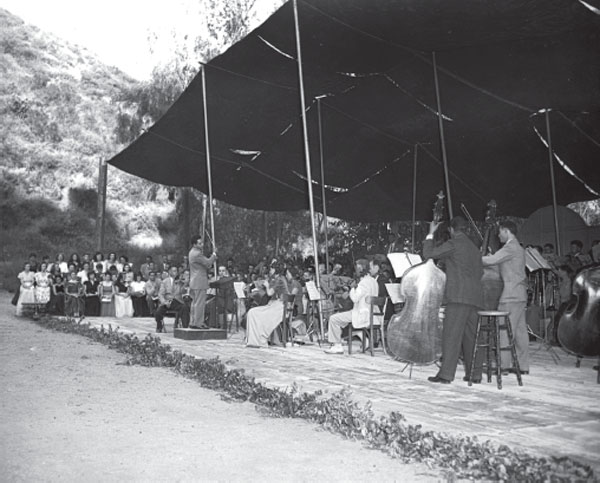
Leo Damiani conducts the Burbank Symphony Orchestra in its rough-and-ready facility in the Verdugo Hills where the Starlight Bowl would later be built, 1946. Collection of Michael B. McDaniel .

A production of Rodgers and Hammerstein’s Oklahoma! is the fare at the Starlight Bowl, 1965. Collection of Michael B. McDaniel .
Nevertheless, during the decades since its 1950 start, the Starlight Amphitheatre has seen many of popular music’s greats perform there: “Weird Al” Yankovic, Bob Marley, Jethro Tull, Nazareth, Black Sabbath, the Kingston Trio, Eric Clapton, Smash Mouth, Flock of Seagulls, Iron Butterfly, Quiet Riot, Berlin, the Outlaws, .38 Special, the Marshall Tucker Band, Lynyrd Skynyrd, Johnny Winter, the Commodores, Rick Springfield, Todd Rundgren, Deep Purple, Don McLean and Genesis. While past financial troubles seem to have been overcome, the problem exists of an outdated infrastructure in need of replacement; plans exist on the Internet showing proposed remodelings. It may be that in coming years the old Starlight Amphitheatre will also be lost.
A bit of present-day lost lore and irony is contained in the Starlight’s address: 1249 Lockheed View Drive. Lockheed is no longer in town to view.
BILL “SUNTAN CHARLIE ” MILLER
Bill “Suntan Charlie” Miller was Frank Sinatra’s pianist and musical associate for decades. He got his ironic nickname from Sinatra, who made fun of his pale skin. From a July 16, 2006 Boston Globe obituary:
Bill Miller, Frank Sinatra’s longtime pianist and closest musical adviser, who accompanied the legendary singer from 1951 until his last performance in 1995, died Tuesday at a Montreal hospital of complications of a heart attack. He was 91. Mr. Miller, who lived in Burbank, CA for more than 50 years, was performing in Montreal with Frank Sinatra Jr. when he broke his hip two weeks ago. He subsequently had a heart attack and died after heart bypass surgery, according to his daughter, Meredith, of Berkeley, Calif .
It should also be pointed out that Bill Miller lived on 949 Country Club Drive, a part of Burbank occasionally subject to floods and mudslides. His house was destroyed, and his wife, Aimee, was tragically killed in a 1964 mudslide when they were swept from their home and carried to a catch basin in a torrent of mud and water. She was forty-seven. Their seventeen-year-old daughter escaped by scrambling up the hill behind the house.
DON’T ROCK IT TOO HARD
We close this musical chapter with our favorite artifact of rock-and-roll from that lost, charmed decade of the 1950s. It’s a piece from the Los Angeles Times that ran on July 12, 1956, entitled, “Teen-agers in Burbank May Rock, but Softly.” The city fathers had to decide how to weigh in when the Parks and Recreation Department turned down a request to permit the Platters to sing at a Saturday night dance in the Olive Recreation Center. (The Platters, of course, are known for their classic mellow hits “Only You,” “The Great Pretender” and “Smoke Gets in Your Eyes.”) A fifteen-year-old named David Friedlander took his record player to city hall and had some officials listen to various Platters hits. Despite reservations, the police chief thought that the songs weren’t too inflammatory, and the decision was made to allow the youngsters to go ahead with the dance. Harmon Bennett, the city manager, had the best quote: “Tell the Platters not to rock it too hard.”
We’d like to be able to report that the Platters did indeed appear, but a Times article the next day reported that the group had a previous engagement in San Diego and couldn’t do the Burbank gig after all.
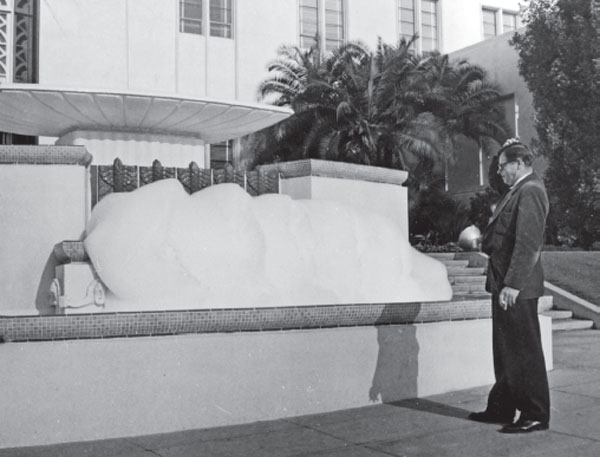
A Burbank city councilman looks at the result of a youthful prank: soap suds in the fountain in front of city hall. And these darn kids want the Platters to rock out here? Collection of Michael B. McDaniel .